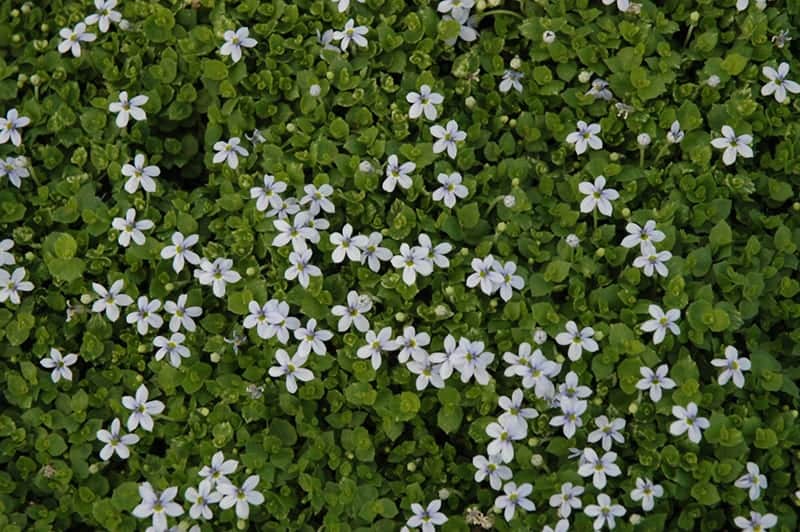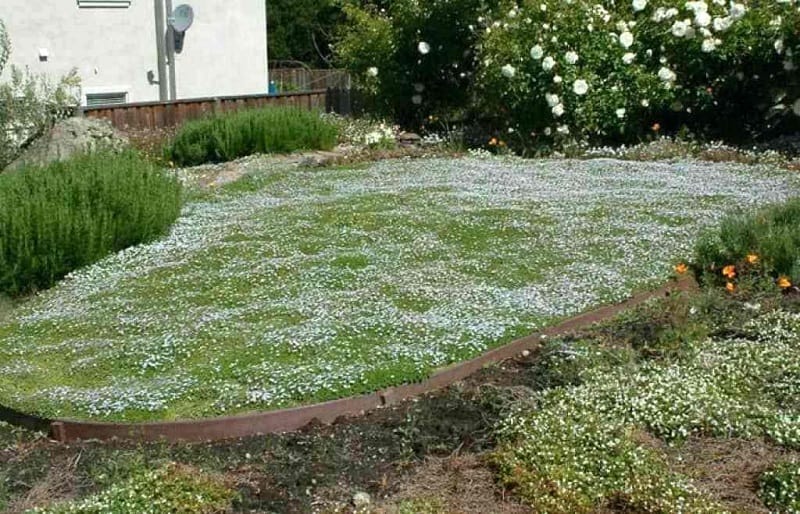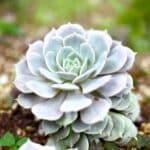Are you considering dumping your lawn and going for a more exciting and beautiful ground cover plant? Blue star creeper is an amazing lawn alternative that you should definitely look at.
Blue star creeper plant is loved by many because it’s easy to plant and maintain, more sustainable, requires less water, and consumes less time than your regular grass.
Unfortunately, you might not know just how to grow and care for this plant, which is why we’re here for you.
In this article, you’ll learn how to plant and care for blue star creeper in your landscape.
But first things first…
Table of Contents
What is Blue Star Creeper?

Scientifically known as Isotoma fluviatilis, Blue Star Creeper is a perennial plant that forms a low-growing mat. The herb was founded in 1810 by Robert Brown and was classified as Isotoma in 1864 by George Bentham.
It’s a ground cover with blue flowers and can be planted in the rock garden, between paving stones, or as a substitute for the lawn. Blue Star Creeper is one of those flowers you cannot write enough good things about.
Furthermore, the plant can grow on top and underneath the ground, sending out runners and creeping via any situation you give it. Blue Star Creeper loves car traffic (with a gravel base), dog foot traffic, and human foot traffic.
It is a remarkable pathway plant, lawn alternative, and the most sensational mulch/bark replacement herb. You can drape it over a wall, grow it in a pot, or stuff it into a wire basket for an exceptional planter.
Isotoma fluviatilis is excellent in Part Sun to Shade in Southern half of America, Full Sun to Part Shade Northern United States. Unfortunately, if you have a severe cold, it may not be the ideal option for you with what climate nature is giving us these days.
However, I think it will do well in a more protected micro-climate in a yard. The plant remains evergreen all through the year and it belongs to the “Campanulaceae” family.
Synopsis of the Plant
Primary Names | Blue star creeper or Swamp isotome |
Scientific/Botanical Name | Isotoma fluviatilis or Laurentia fluviatilis |
Family | Campanulaceae |
Origin | New Zealand, Asia, and Australia |
Height | Short, 2-15 inches |
Water | Evenly moist soil, medium water needs |
Light | Partial to full sun |
Bloom time | Early spring to early fall |
Flower Color | Light blue |
Foliage Color | Deep green |
Leaf | Small, evergreen, bright green, quadrilateral |
Growth Rate | Medium |
Special Features | Groundcover, Rabbit/Deer resistant |
Types of Blue Star Creeper
This plant comes in sub-species that primarily differ in their sizes and leaf shapes:
Isotoma fluviatilis subsp. Fluviatilis
Isotoma fluviatilis subsp. Fluviatilis is one of the sub-species of blue star creeper. It has 5-15mm long leaves and 4-7mm in length hairless corolla.
Fluviatilis’s female flower has 4-6mm long corolla with pale and small anthers without pollen.
Isotoma fluviatilis subsp. Australis
This blue star creeper sub-specie has 7-15mm long corolla and leaves that’s 5-13 mm long. The leaves width varies between 2-7mm. The corolla is mainly blue in color but you may also find a few in pink color.
Isotoma fluviatilis subsp. Borealis
Borealis is almost the same thing as Australis, which often makes it hard to differentiate between them. The corolla for Borealis subspecies of the plant is 6-10mm long – and the leaves are usually between 2-5mm wide and 5-12mm long.
As for the flowers, you will find around 5-40mm long pedicels. Lobes and corolla are hairy inside and ovary in Borealis is hairless.
Blue Star Creeper Care
Interestingly, blue star creeper does not require so much care. While the herb is draught-tolerant, it benefits more from extra moisture in full sunlight or during dry, hot weather.
Applying any all-purpose garden fertilizer prior to new growth in spring will also help to nourish the plant throughout the growing season. Shaving the plant down to about 1-inch in autumn equally helps keep it tidy during the winter periods.
That said, here’s how to properly care for this beautiful ground cover herb.
Water requirement
Regular watering is needed for the best growth of the plant. Proper watering is important, especially in the first year of growth. This will help it to firmly establish itself in the soil.
After this period, it becomes drought-resistant. It’s worth mentioning; however, that blue star creeper does not like to sit in water. Therefore, you must be careful about the place you plant it.
You don’t want to plant it in lower spots that may be prone to holding water after rain. Regardless of its drought-tolerance, you’re still required to water it properly during dry and hot weather, else it’ll die.
Light requirement
This needs enough light to grow, so it’s advisable to plant them in sunny or somewhat sunny areas. Full shade is not advisable if you live in a warmer zone.
Bottom line: Planting blue star creeper in an area that has direct sunlight for most of the time will negatively affect its growth.
Fertilizer
You don’t necessarily need to fertilize it so far you have quality soil. But as I mentioned earlier, an application of an all-purpose garden fertilizer before the growing season will certainly help to recondition your soil before planting.
Soil
It flourishes more in well-draining, moist soil that does not get too hot throughout the day. As a ground cover, it performs well when interplanted between trees, larger shrubs, or bushes.
Blue Star Creeper Propagation
There are basically two ways to propagate Isotoma fluviatilis:
The first option is to divide the root ball or seeds. You can easily divide the root ball. Scrape the soil gently from the roots either by using your hand or sharp pruning shears. Then split the root ball and plant it in the ground or in your preferred pot, and that’s it.
The second way is somewhat complex to carry out. You need to let the seed pods dry on the plant, after which they should be crushed in an air-tight container to get the seeds. And once you’ve collected the seeds, they should be sprinkled on a moistened seed starting mix.
When the seeds are distributed evenly on the seed mix, get a newspaper and place it on the container. Ensure to leave a little gap between the surface of the container and the soil. This will give the blue star creeper seeds a good place to grow.
Remember to keep the container moist and in partial sunlight for about 7 to 15 days. And once the seedlings get to the six-leaf stage, they should be planted in the ground or your chosen location.
Pruning
Judging by the fact that the plant is not native to the US, it can spread very quickly, which made it invasive in nature.
The fast growth occurs when the plant is over-watered or when you apply more fertilizer than necessary. You can use a deep landscape edging material to prevent unwanted spreading, or simply hand pull any extra growth.
Repotting
If you’re growing it in containers as an ornamental or houseplant, then you can repot it at will. Once the plant starts outgrowing a pot, divide it up into different pots, or simply size your pot up by 1 inch or thereabout.
Blue Star Creeper Problems

One thing to be really excited about is the fact that this easy to care for ground cover herb won’t give you lots of troubles in your garden.
Provided you’re protecting and watering it very well, you won’t experience too many growing problems.
Additionally, the plant rarely gets into trouble with diseases or pests but may face some issues if you disregard its growing requirements.
Growing Problems
If you water the plants too much, they will quickly grow and spread all over the ground. While it may sound good to have your garden surrounded by blue flowers, at some point, it will start to occupy other areas of your garden or yard that you’d rather dedicate to other plants.
Meanwhile, overwatering can equally be a problem if you have heavy clay soil that retains too much water. Overwatering can easily kill the plant.
Blue star creeper is basically not an invasive plant by classification; however, it can grow in a pattern that looks like an invasive species if its growing environment is favorable to rapid growth.
Diseases
Blue flowers groundcover is liable to fungal diseases that block the roots’ growth and development ability.
Therefore, you will want to plant it in areas that are moist but well-drained to prevent horrible fungal infections such as leaf spot, damping off, etc.
Pests
You don’t have to worry too much about pests as long as blue star creeper lawn care is concerned. This is because the low-spreading herb is totally not bothered by insects.
You also won’t have to be too concerned about rabbits making a home in your lawn as the plant is resistant to them too.
How To Plant Blue Star Creeper
Plant blue star creeper in a sunny or somewhat sunny spot with well-drained soil. This amazing plant has few special needs, but it doesn't like to sit in water so don't plant it in a low spot that holds water after heavy rains.
Frequently Asked Questions
Can I plant blue star creeper in a container?
Yes, having this beautiful plant grow in a container is a wonderful way to enjoy it without it spreading all over the place.
Does Blue Star Creeper attract bees?
Yes, the flowers do seem to attract small bees, hoverflies and/or wasps.
Is Blue Star Creeper poisonous?
All parts of Blue Star Creeper are toxic if ingested, so you have to keep your kids and pets away from it.
Aside from that, people that have sensitive skin might also suffer an allergic reaction when handling the plant.
What fertilizer should I use for the plant?
You can use any all-purpose plant fertilizer. Nourishing the soil with organic compost can also help with growth.
Is Blue Star Creeper invasive?
No, the plant is not invasive by classification but can grow in a way that looks like an invasive species if it’s in a favorable growing environment.
Is Blue Star Creeper drought tolerant?
Yes, blue star creeper is drought tolerant, but benefits from a little extra moisture during dry, hot weather or in full sunlight.
How do I get rid of blue star creeper?
One of the best ways to get rid of blue star creeper is by overseeding the location where the plant was growing with your desired grass seed, keeping the area very moist for the first growing season.
You’ll have to wait for about 2 to 4 weeks for this task if you made use of an herbicide. If the plant sprouts, pull them (together with the roots) from the ground immediately and discard.
Conclusion
This plant is a very gorgeous plant, regardless of where you place it – whether you want to use it to fill the edges of a pond or to form a low, dense mat between stepping stones – it’ll certainly serve you very well.
The best part, as you can see from the article, is that it’s also pretty easy to maintain and care for. So if you’re wondering about the perfect replacement for your lawn right now, you should really check out blue star creeper.





Leave a Reply